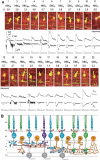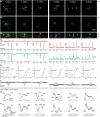Synaptic organization of the vertebrate retina: general principles and species-specific variations: the Friedenwald lecture
- PMID: 20185835
- PMCID: PMC3258978
- DOI: 10.1167/iovs.09-4396
Synaptic organization of the vertebrate retina: general principles and species-specific variations: the Friedenwald lecture
Figures




Similar articles
-
Photoreceptor membrane proteins, phototransduction, and retinal degenerative diseases. The Friedenwald Lecture.Invest Ophthalmol Vis Sci. 1998 Dec;39(13):2491-513. Invest Ophthalmol Vis Sci. 1998. PMID: 9856758 Review. No abstract available.
-
Photopigments and seeing--lessons from natural experiments: the Proctor lecture.Invest Ophthalmol Vis Sci. 1998 Nov;39(12):2204-16. Invest Ophthalmol Vis Sci. 1998. PMID: 9804128 Review. No abstract available.
-
Keeping an eye on the time: the Cogan Lecture.Invest Ophthalmol Vis Sci. 2002 May;43(5):1286-98. Invest Ophthalmol Vis Sci. 2002. PMID: 11980836 No abstract available.
-
G protein signaling in the retina and beyond: the Cogan lecture.Invest Ophthalmol Vis Sci. 2014 Dec 15;55(12):8201-7. doi: 10.1167/iovs.14-15928. Invest Ophthalmol Vis Sci. 2014. PMID: 25511392 Free PMC article. No abstract available.
-
Rhodopsin structure, function, and topography the Friedenwald lecture.Invest Ophthalmol Vis Sci. 2001 Jan;42(1):3-9. Invest Ophthalmol Vis Sci. 2001. PMID: 11133841 Review. No abstract available.
Cited by
-
Quantitative biology of single neurons.J R Soc Interface. 2012 Dec 7;9(77):3165-83. doi: 10.1098/rsif.2012.0417. Epub 2012 Aug 22. J R Soc Interface. 2012. PMID: 22915636 Free PMC article. Review.
-
Assessment of area and structural irregularity of retinal layers in diabetic retinopathy using machine learning and image processing techniques.Sci Rep. 2024 Feb 18;14(1):4013. doi: 10.1038/s41598-024-54535-6. Sci Rep. 2024. PMID: 38369610 Free PMC article.
-
Characterization and staging of outer plexiform layer development in human retina and retinal organoids.Development. 2021 Dec 1;148(23):dev199551. doi: 10.1242/dev.199551. Epub 2021 Dec 8. Development. 2021. PMID: 34738615 Free PMC article.
-
Olfactomedin-like 2 A and B (OLFML2A and OLFML2B) profile expression in the retina of spotted gar (Lepisosteus oculatus) and bioinformatics mining.Fish Physiol Biochem. 2019 Oct;45(5):1575-1587. doi: 10.1007/s10695-019-00647-0. Epub 2019 May 20. Fish Physiol Biochem. 2019. PMID: 31111317
-
Human Occipital and Parietal GABA Selectively Influence Visual Perception of Orientation and Size.J Neurosci. 2017 Sep 13;37(37):8929-8937. doi: 10.1523/JNEUROSCI.3945-16.2017. Epub 2017 Aug 14. J Neurosci. 2017. PMID: 28821653 Free PMC article.
References
-
- Cajal SR. La retine des vertebres. La Cellule. 1893;9:17–257
-
- Baylor DA. Photoreceptor signals and vision: The Proctor Lecture. Invest Ophthalmol Vis Sci. 1987;28:34–49 - PubMed
-
- Yau KW. Phototransduction mechanism in retinal rods and cones: The Friedenwald Lecture. Invest Ophthalmol Vis Sci. 1994;35:9–32 - PubMed
-
- Dowling JE. The Retina, an Approachable Part of the Brain. Boston: Harvard University Press; 1987.
-
- Wassle H. Parallel processing in the mammalian retina. Nat Rev Neurosci. 2004;5:747–757 - PubMed
Publication types
MeSH terms
Grants and funding
LinkOut - more resources
Full Text Sources

